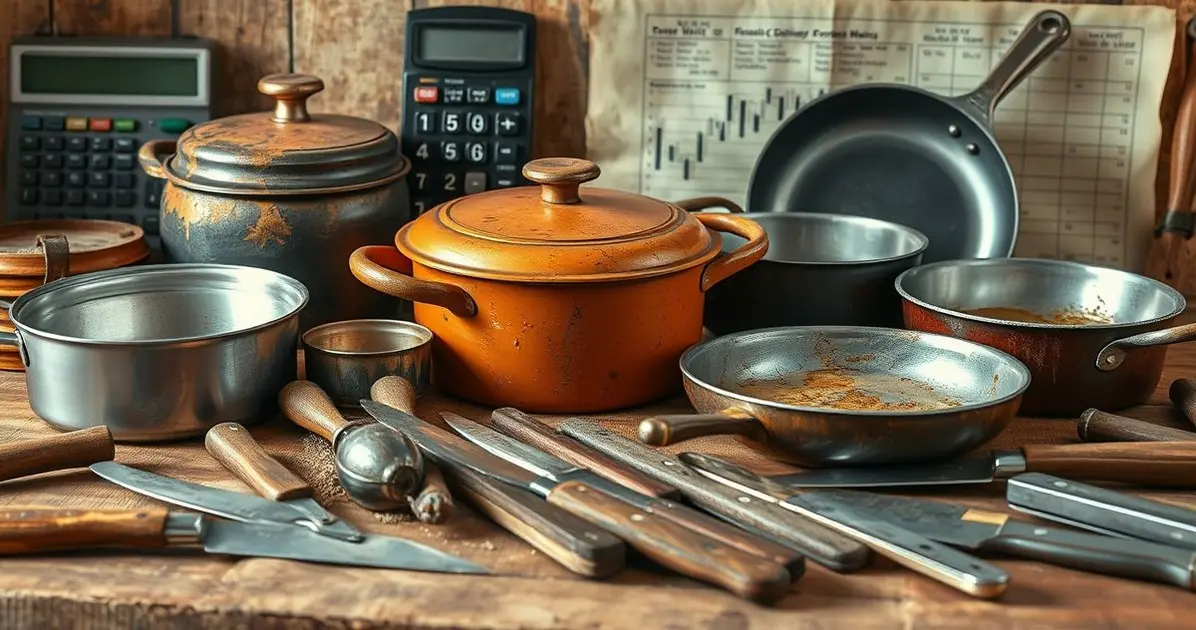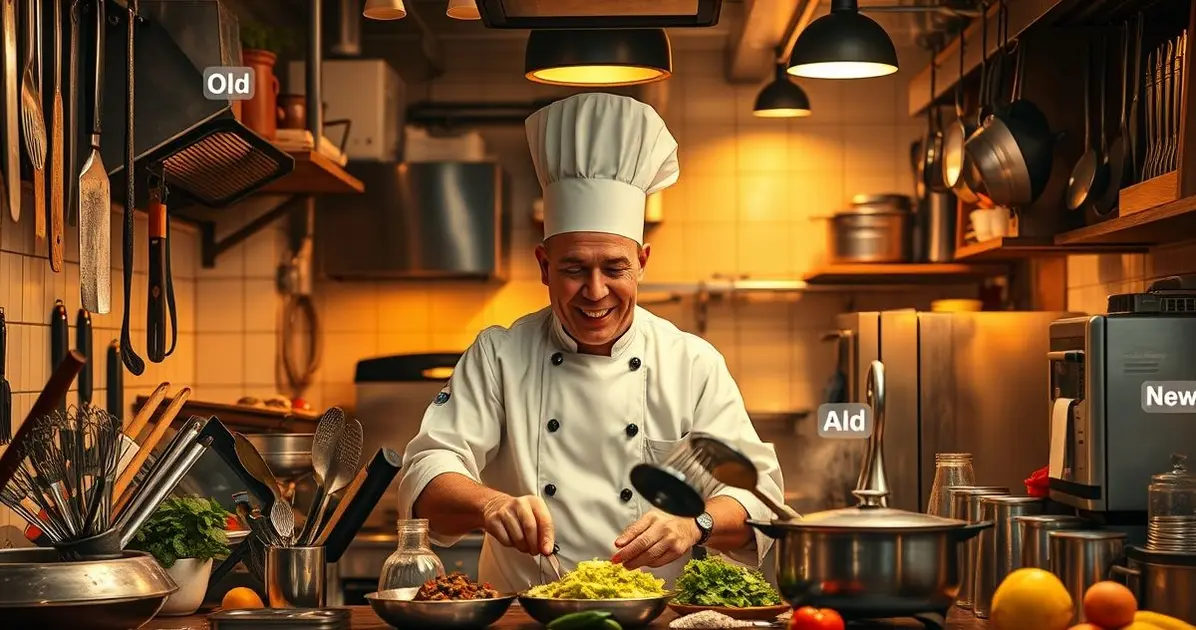Cooking tools and equipment are essential for any kitchen, but just like any other asset, they undergo wear and tear over time. This leads to the question of whether they are subject to depreciation.
Are cooking tools and equipments subject to depreciation

Cooking tools and equipment do experience depreciation due to their usage and wear over time. As they age, their value diminishes, affecting accounting practices for businesses. Understanding this can help in budgeting and tax preparation.
What is Depreciation?
Depreciation is an accounting concept that refers to the reduction in value of an asset over time. This decrease in value occurs due to various factors, including wear and tear, obsolescence, and market fluctuations. In simpler terms, depreciation is how we account for the fact that assets, like cooking tools and equipment, lose their value as they age and are used.
For cooking tools, depreciation is particularly relevant because it helps individuals and businesses understand the financial implications of their investments. When you purchase a new kitchen appliance or a set of high-quality knives, they start to lose value the moment you start using them. This is important for budgeting, as you need to consider how long these items will last and how much they will be worth when it’s time to replace them.
In accounting, there are several methods used to calculate depreciation, including straight-line depreciation, declining balance, and units of production. The most common method, straight-line depreciation, spreads the cost of an asset evenly over its useful life. For example, if you buy a commercial oven for $5,000 and expect it to last for 10 years, you would allocate $500 in depreciation expense each year.
Understanding depreciation not only helps in tracking the value of your cooking tools but also plays a crucial role in tax reporting. For businesses, being able to deduct depreciation expenses can reduce taxable income, providing potential tax savings. This makes it essential for culinary entrepreneurs to keep accurate records of their equipment and its depreciation.
In summary, depreciation is a key concept that affects the financial management of cooking tools and equipment. By grasping how depreciation works, you can make more informed decisions regarding your kitchen investments, whether for personal use or in a professional culinary setting.
Factors Influencing Depreciation of Cooking Tools
Several factors influence the depreciation of cooking tools and equipment, affecting their value over time. Understanding these factors can help you make informed decisions about purchasing, maintaining, and replacing your kitchen tools. Here are the key elements that contribute to the depreciation of cooking tools:
1. Wear and Tear: As you use cooking tools, they naturally experience wear and tear. Frequent chopping, stirring, and cooking can lead to scratches, dents, and other forms of damage that reduce the value of your utensils and appliances. For instance, a knife that has been sharpened multiple times may lose its original shape and efficiency, contributing to its depreciation.
2. Obsolescence: Cooking tools can become obsolete due to advancements in technology and changes in consumer preferences. For example, a traditional blender may be replaced by a high-performance immersion blender or a powerful food processor that offers more features. As newer models enter the market, older tools may lose their appeal and market value.
3. Market Demand: The demand for specific cooking tools can fluctuate based on trends, culinary practices, and consumer interests. If a particular gadget becomes less popular, its resale value may decline. Conversely, tools that are in high demand may retain their value better. For instance, specialty items like sous-vide machines may see a surge in popularity, positively impacting their depreciation rate.
4. Quality of Materials: The materials used in the construction of cooking tools can significantly impact their depreciation. High-quality materials, such as stainless steel or durable plastics, tend to withstand the test of time better than cheaper alternatives. A well-made knife, for example, may retain its value longer than a flimsy plastic spatula due to its durability and performance.
5. Maintenance and Care: How you care for and maintain your cooking tools plays a crucial role in their depreciation. Regular cleaning, proper storage, and timely repairs can extend the lifespan of your tools and help maintain their value. For instance, sharpening knives and oiling wooden utensils can prevent deterioration and keep them in good condition.
In summary, understanding the factors influencing the depreciation of cooking tools can help you make better purchasing decisions and manage your kitchen investments effectively. By considering wear and tear, obsolescence, market demand, quality of materials, and maintenance practices, you can minimize the impact of depreciation on your cooking tools.

Impact of Depreciation on Home Chefs vs. Culinary Businesses
The impact of depreciation on cooking tools and equipment varies significantly between home chefs and culinary businesses. Understanding these differences can provide valuable insights for budgeting, purchasing, and managing kitchen investments.
For Home Chefs: Depreciation affects home chefs primarily in terms of personal budgeting and replacement planning. As home chefs invest in various tools, such as high-quality knives, pots, and small appliances, they need to be aware that these items will lose value over time. This understanding can help them prioritize which tools to invest in and when to replace them. For instance, a home chef may choose to invest in a durable chef’s knife that can last for years, knowing that its value will decrease but its performance will remain high.
Additionally, home chefs can benefit from understanding depreciation when it comes to tax deductions. While the tax implications may not be as significant as for businesses, knowing the depreciation of valuable kitchen tools can still provide some financial relief if they decide to sell or upgrade their equipment.
For Culinary Businesses: The impact of depreciation is much more pronounced in culinary businesses, where cooking tools and equipment represent significant investments. Restaurants and catering companies must track the depreciation of their assets for financial reporting and tax purposes. Accurate depreciation calculations can affect profit margins, cash flow, and overall financial health.
Culinary businesses often use depreciation to write off the cost of equipment over its useful life, which can lead to substantial tax savings. For example, if a restaurant invests in a commercial oven, understanding its depreciation schedule allows the owner to deduct a portion of the oven’s cost each year, ultimately reducing taxable income.
Moreover, culinary businesses need to be proactive about replacing depreciated equipment to maintain efficiency and quality. As tools and appliances age, they may require more frequent repairs or replacements, impacting operational costs. Businesses must balance the cost of maintaining older equipment against the benefits of investing in newer, more efficient tools.
In summary, while both home chefs and culinary businesses face the impact of depreciation on cooking tools, the stakes and implications differ. Home chefs should consider depreciation for personal budgeting and investment decisions, while culinary businesses must actively manage depreciation for financial reporting, tax deductions, and operational efficiency. Understanding these nuances can help both groups make informed decisions about their kitchen investments.
Maintaining Cooking Tools for Longevity and Tax Benefits
Maintaining your cooking tools is crucial not only for ensuring their longevity but also for maximizing potential tax benefits. Proper care can help you get the most out of your investments, whether you’re a home chef or running a culinary business. Here’s how to effectively maintain your cooking tools for both durability and financial advantages.
1. Regular Cleaning: One of the simplest ways to maintain your cooking tools is through regular cleaning. After each use, make sure to wash utensils, pots, and pans thoroughly to remove food particles and grease. For knives, hand washing is recommended to prevent damage to the blades. Keeping your tools clean not only extends their lifespan but also ensures they remain safe and hygienic for food preparation.
2. Proper Storage: How you store your cooking tools can significantly impact their longevity. Knives should be stored in a knife block or on a magnetic strip to protect their edges. Utensils can be organized in drawers or containers to prevent scratches and damage. For pots and pans, stacking them with protective liners can help avoid scratches and dents. Proper storage prevents unnecessary wear and tear, keeping your tools in good condition for longer.
3. Regular Maintenance: Beyond cleaning, regular maintenance is essential for the longevity of cooking tools. This includes sharpening knives, oiling wooden utensils, and checking appliances for wear. For example, sharpening your knives every few months keeps them effective and safe to use. Similarly, applying food-safe mineral oil to wooden utensils helps prevent cracking and drying out.
4. Documenting Expenses: For culinary businesses, maintaining cooking tools can also lead to tax benefits. Keeping detailed records of your equipment purchases, maintenance costs, and depreciation can provide valuable documentation for tax deductions. When you invest in new tools or replace old ones, these expenses can often be written off, reducing your taxable income.
5. Understanding Depreciation: By understanding the depreciation of your cooking tools, you can make informed decisions about when to replace them. For instance, if you know that a particular appliance typically lasts five years, you can plan your budget accordingly. This proactive approach not only helps in maintaining your tools but also maximizes your tax benefits by ensuring you’re aware of the value of your investments.
In summary, maintaining your cooking tools is vital for ensuring their longevity and maximizing potential tax benefits. By implementing regular cleaning, proper storage, routine maintenance, and keeping accurate records, you can enhance the lifespan of your tools while also benefiting financially. Whether cooking at home or managing a culinary business, these practices will help you protect your investments and keep your kitchen running smoothly.
Conclusion
In conclusion, understanding the concept of depreciation and its impact on cooking tools is essential for both home chefs and culinary businesses.
By recognizing how cooking tools lose value over time and the various factors that influence this depreciation, you can make informed purchasing and budgeting decisions.
For home chefs, being aware of depreciation helps in planning for replacements and managing kitchen investments effectively.
Meanwhile, culinary businesses must actively track depreciation for financial reporting and tax benefits, ensuring that they maintain a healthy bottom line.
Moreover, maintaining your cooking tools through regular cleaning, proper storage, and routine maintenance not only extends their lifespan but can also lead to significant tax advantages.
By keeping detailed records of your equipment and understanding their depreciation schedules, you can maximize your financial benefits.
Ultimately, whether you’re cooking at home or running a professional kitchen, a solid grasp of depreciation and maintenance will empower you to protect your investments and enhance your culinary experience.
Embrace these practices to ensure that your cooking tools serve you well for years to come!
FAQ – Frequently Asked Questions about Cooking Tools Depreciation and Maintenance
What is depreciation in the context of cooking tools?
Depreciation refers to the reduction in value of cooking tools over time due to factors like wear and tear, obsolescence, and market demand.
How does depreciation affect home chefs compared to culinary businesses?
Home chefs need to understand depreciation for budgeting and replacement planning, while culinary businesses must track it for financial reporting and tax deductions.
What factors influence the depreciation of cooking tools?
Factors include wear and tear, obsolescence, market demand, quality of materials, and maintenance practices.
How can I maintain my cooking tools for longevity?
Regular cleaning, proper storage, and routine maintenance such as sharpening knives and oiling wooden utensils can extend the lifespan of your tools.
Are there tax benefits associated with maintaining cooking tools?
Yes, keeping detailed records of equipment purchases and maintenance can provide documentation for tax deductions related to depreciation.
What should I do if my cooking tools are depreciating quickly?
Evaluate their condition, consider proper maintenance, and assess if it’s time to replace them with higher-quality tools that may hold their value better.
See more
Discover plenty of easy and delicious recipes you can make at home, from hearty dinners to indulgent desserts and wholesome breakfasts.




